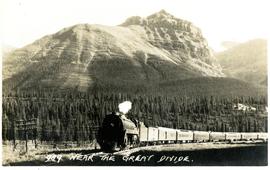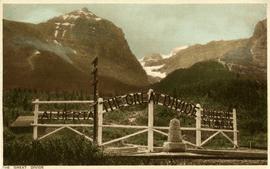Postcard depicts Stoney Creek Bridge.
Postcard depicts Macdonald Range, near Glacier B.C.
Postcard depicts Glacier House, CPR, and Hermirt Range, Selkirk Mountains.
Postcard depicts Hermit Range and Rogers' Pass, CPR.
Postcard depicts the east portal of the Connaught Tunnel.
Postcard depicts Glacier Station.
Postcard depicts Illecillewaet Valley and Loop near Glacier, BC
Postcard depicts Illecillewaet Valley from Lookout Point on Mt. Abbott, near Glacier B.C.
Postcard depicts "The Four Tracks."
Postcard depicts Imperial Limited on the Great Loop in the Selkirks, near Glacier, BC
Postcard depicts the Illecillewaet Valley, near Glacier, BCThe view shows the end of the descent over Rogers Pass, if travelling westerly. The scar in the foreground was believed to be the track between the 1st (Glacier Hotel) and 2nd (Loop Brook) loops.
Postcard depicts "The Loop," CPR, Selkirk Mountain.
Postcard depicts the west portal of the Connaught Tunnel, near Glacier, BCDavies noted the ventilation engine house above the entrance.
File consists of postcards collected by David Davies of the CPR line from Revelstoke to Savona, British Columbia.
Postcard depicts the Kamloops CPR depot and gardens.
Postcard depicts Main Street (Victoria West) Kamloops in 1910.
Postcard depicts a "4-4-0 woodburning locomotive at Shuswap Station, east of Kamloops, at the turn of the century. The completion of the CPR across the Continent, guaranteed B.C.'s entry into Cinfederation, as well as reg economic and cultural connection to the East."
Postcard depicts Cathedral Mountain on the Canadian Pacific Railway.
Postcard depicts the Lake Louise CPR depot.
Postcard depicts Field station in the Rockies. Man standing on the left with a bowler hat was Chris McGregor, a professional (mining?) engineer. Earliest frank seen for the postcard was in July 1906.
Postcard depicts Cathedral Mountain.
Postcard taken on Field Hill, along the CPR line.
Postcard depicts a spiral tunnel near Field, in which trains make a complete turn around the Canadian Rockies. One of two spiral tunnels, and the first of this system introduced on the continent. The greatest pieced of tunnelling ever attempted in Canada. Cost 1,5000,000. Time of work: 20 months. 75 car-loads of dynamite used.
Postcard depicts a train exiting a tunnel along the CPR line.
Postcard depicts the Great Divide between Alberta and British Columbia, along the CPR line.
Postcard depicts the passage through the shoulder of Mt. Stephen.
Postcard depicts Mt. Stephen and Field, BC
Postcard depicts Kicking Horse Canyon.
Postcard depicts Mt. Stephen and Kicking Horse River.
Postcard depicts the Kicking Horse Canyon near Yoho National Park.
Postcard depicts Mt. Stephen, Field, BC
Postcard depicts Kicking Horse Canyon near Mt. Field.
Postcard depicts the Canadian Pacific Railway line where the Great Divide between BC and Alberta.
Postcard depicts Castle Mountain found along the Canadian Pacific Railway line.
Postcard depicts one of the upper sprial tunnels in Field, BC
Postcard depicts a train entering a lower spiral tunnel. Mount Stephen visible.
Postcard depicts a lower spiral tunnel along the CPR line near Field, BC
Postcard depicts Kicking Horse Canyon.
Government map depicts railway lands, lands "disposed of", grazing leases, and timber berths. Shows the British Columbia 'railway belt' running from Greater Vancouver to Field, B.C.
Series consists of large format maps and plans relating to railways in British Columbia and Canada. Also includes oversize documents.
Postcard depicts the CPR main line near Yoho, BC
Postcard depicts Cathedral Mountain viewed from a tunnel in the Canadian Rockies.
Postcard depicts a spiral tunnel near Field B.C. Mount Stephen visible.
Postcard depicts a general view of new grade reduction loops and spiral tunnels near Field B.C., Canadian Rockies.
Postcard depicts spiral tunnels.
Postcard taken at the Laggan Subdivision, the most famous photograph location on the CPR system due to its official photographer, Nicholas Morrant, 1910-1986. Possibly a 1920's view. From 1978, this location became known as 'Morant's Curve.' This view was a rarity in showing no train on the track.
Postcard depicts spiral tunnels near Yoho National Park, BC
Postcard depicts Mt. Stephen.
Technical drawing of Kettle Valley Railway depicts trackage and a gradient profile for the line.
Postcard depicts Cathedral Mountain viewed from a spiral tunnel in the Canadian Rockies.

